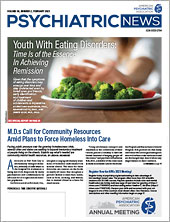APA has released an updated practice guideline on how to treat patients with eating disorders— the first full update since 2006.
There have been many clinical advances and diagnostic changes related to eating disorders in the past 17 years, noted Laura Fochtmann, M.D., M.B.I., a professor of psychiatry, pharmacological sciences and biomedical informatics at Stony Brook University School of Medicine and the medical editor for APA’s practice guidelines. Fochtmann was also the vice-chair of the writing group for this newest practice guideline.
Notably, the publication of DSM-5 in 2013 and DSM-5-TR in 2022 resulted in broader diagnostic criteria for both anorexia nervosa and bulimia nervosa as well as the additions of binge-eating disorder and avoidant/restrictive food intake disorder (ARFID) categories. Binge-eating and avoidant/restrictive food intake disorders are both referenced in the updated guideline: There is a comprehensive section on assessing and treating binge-eating disorder, and there is also information on assessing patients with ARFID, Fochtmann noted. (Due to limited clinical data, there are no specific recommendations for how to treat patients with ARFID.)
The fourth edition of APA’s practice guideline for eating disorders includes 16 clinical recommendations or suggestions, depending on the level of scientific evidence. Here are some of the recommendations:
•
Screening for the presence of an eating disorder as part of an initial psychiatric evaluation.
•
Conducting comprehensive patient evaluations, including laboratory tests such as electrocardiograms.
•
Ensuring the treatment plan is patient-centered and culturally sensitive.
•
Setting individualized weight goals for patients with anorexia.
•
Treating patients with anorexia, bulimia, and binge-eating disorders with eating disorder–focused psychotherapy.
•
Including family-based therapy as part of a treatment plan for adolescents with anorexia or bulimia.
In addition to the guideline, APA has developed supplemental materials to help both health professionals and patients and families, such as a clinician pocket guide and educational slides. The centerpiece of these resources is an online tool that offers a step-by-step guide on how to assess symptoms and screen patients for a potential eating disorder. This clinical decision tool will be customized for different professionals (for example, psychiatrists, psychologists, and pediatricians) to match their skillsets and the symptoms they might expect when encountering someone with an eating disorder.
The development of the online toolkit and other supporting resources was made possible through a grant from the Council of Medical Specialty Societies.
The release of this new practice guideline comes at an important juncture for people with eating disorders (“
Special Report: Youth With Eating Disorders—Time Is of the Essence in Achieving Remission”). Studies have reported upticks in individuals developing symptoms of and requiring hospitalization for disordered eating since the start of the COVID-19 pandemic in 2020. As noted in the guideline, maintaining a structured plan for meals and snacks is an important component of treatment, and the pandemic disrupted normal routines and increased stress and anxiety.
“Early identification and treatment of an eating disorder is critical for achieving positive long-term outcomes,” said Joel Yager, M.D., a professor emeritus of psychiatry at the University of Colorado School of Medicine and the chair of the writing group for all three previous editions of the eating disorder practice guideline. “We hope that this tool will help anyone make an informed diagnosis regardless of their previous experience with eating disorders.” ■
